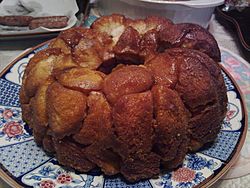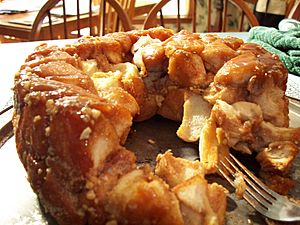Monkey bread facts for kids
 |
|||||||
| Alternative names | Pull-apart bread, bubble bread, Christmas morning delights | ||||||
|---|---|---|---|---|---|---|---|
| Type | Bread or pastry | ||||||
| Course | Breakfast | ||||||
| Place of origin | Hungary | ||||||
| Main ingredients | bread flour | ||||||
| 352 kcal (1474 kJ) | |||||||
|
|||||||
Monkey bread (also known as pull-apart bread or bubble bread) is a yummy, sweet, and sticky pastry. People in the United States often eat it for breakfast or as a special treat. It's made of soft, baked dough pieces, usually sprinkled with cinnamon and sugar. You might find it at fun fairs and festivals!
Contents
Why is it called Monkey Bread?
The name "monkey bread" comes from how you eat it. You don't use a knife or fork. Instead, you pull apart the soft pieces with your fingers, just like a monkey might pick at its food!
Where did Monkey Bread come from?
What many people call monkey bread today actually started as a Hungarian dessert. Its original name is arany galuska, which means "golden dumpling." This sweet dish has been around in Hungarian writings since the 1880s.
How it came to America
When Hungarian immigrants moved to America, they brought their delicious recipes with them. In the mid-1900s, Hungarian and Hungarian-Jewish bakeries in the U.S. started selling arany galuska.
In 1972, a famous cookbook by Betty Crocker shared a recipe for arany galuska. They called it "Hungarian Coffee Cake." As this dessert became more popular in America, people started to confuse it with another dish called "monkey bread." The "monkey bread" name soon became more common for this tasty Hungarian-Jewish dessert.
Recipes for this pull-apart bread first appeared in American women's magazines and community cookbooks in the 1950s. Later, in the 1980s, Nancy Reagan, who was the First Lady of the United States, helped make monkey bread very popular. She often served it during Christmas at the White House!
How to make Monkey Bread
Monkey bread is made with pieces of sweet yeast dough. Sometimes, people even use frozen dough to make it easier! Each piece of dough is first covered in melted butter, cinnamon, and sugar. Then, all the pieces are baked together in a special cake pan at a high temperature.
Sometimes, chopped pecans are added for extra crunch and flavor. Monkey bread is usually served hot. This makes it super easy to tear off the baked pieces with your fingers and enjoy them by hand!
See also
 In Spanish: Monkey bread para niños
In Spanish: Monkey bread para niños


